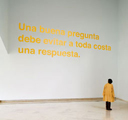- CA2M MUSEUM
- Activities
- LOOKING AT THE PRESENT
LOOKING AT THE PRESENT

The notion commonly built around current art and its creators usually appears as linked to the discourse spread by mass media. Therefore, it is perceived as a legacy of a romantic ideal and modern paradigm which conceive art as autonomous. But artistic production created under aesthetic and thought paradigms since post-modernity has given up on the autonomy of the artistic object and is starting to look beyond the traditional conception of Art: it is related to its environment and deals with other current actors to build a discourse.
In Looking at the present. Seven sessions to think about current art, we will have theoreticians and artists analysing, along with some of their proposals, subjects that affect in depth the way we perceive ourselves in the late-capitalist context: our shared past, our role as spectators-citizens, the way we relate with authority or the influence of the institutions on ways of life are only some of the debates’ starting points. This way of thinking with objects and art images may be the only possible approach to find out about its dialectical capacity as well as its capacity for agency. So that, in the end, we’ll see the way art lives amongst us as a manner of looking critically at the present.
The CA2M offers a number of training activities in contemporary art and philosophy as part of its public education programmes specifically designed for young people and adults.These courses offer a clear and concise insight into some of the basic concepts for understanding and interpreting contemporary art. The activities are divided into two parts: the first part consists of the introduction of a theme by a guest speaker, who in the second part opens the floor to a discussion involving the participants.This seven-session course will be completed by a tour to the exhibition Before everything.
WED 20 OCT
Course Presentation and Introduction
Pablo Martínez. Head of Education and Public Activities.
Ferran Barenblit. CA2M director
WED 27 OCT
Yayo Aznar, PhD in Art History, is currently teaching as a tenured professor in the Art History Department of the UNED University in Madrid.
Amongst her publications, some books like El cauce de la memoria. Arte en el siglo XIX (Madrid, Istmo, 1998), Arte de acción (Madrid, Nerea, 2000), La memoria pública (Madrid, Universidad Nacional de Educación a Distancia, 2002), El Guernica (Madrid, Edilupa, 2004) or La memoria compartida. España y Argentina en la formación de un imaginario cultural (Buenos Aires, Paidós, 2005) are particulary worth pointing out. In addition, she is co-manager with Javier Hernando Carrasco of the collection Arte Hoy, published by Nerea’s publishing company.
WED 3 NOV
Dora García (Valladolid, 1965) is an artist focused on dismantling conventions and codes of conduct in particular those between the artwork, the artist and the spectator by use of performance, or an unusual treatment of the exhibition space.
WED 10 NOV
Pablo Marte (Cadiz, 1975) works with videos playing with its fictionality and facing it to reality. In his work, we can also sense a political concern captured by his treatment of the relation between body and space.
WED 17 NOV
Since the mid-sixties, Isidoro Valcárcel Medina (Murcia, 1937) is a conceptual artist who has been questioning, through his work, the status of the artwork and its aestheticized value as well as the institutional frameworks where it takes place. His practice goes from experimental poetry, music and mail art to film, performance or sound intervention.
WED 24 NOV
Fernando García (Madrid, 1975) works intentionally mixing formats to deal with different concerns related to his personal experience and condition of artist. As a matter of fact, his pieces refer ironically to contradictions on the contemporary creator position and the structures of the art world.
WED 1 DIC
David Bestué and Marc Vives (Barcelona, 1980 and 1978 respectively) collaborate as artists since 2002. Their work consists of incisions on quotidianness through fictional elements using a plurality of references on art history as well as philosophical or popular culture.
Educational programme 2010 - 2011